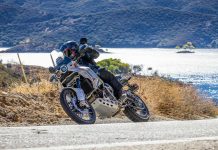Oh, track days, what’s not to like? Turning laps with buddies and improving skills is always money well spent. Of course, that usually means racier tire compounds that require hassling with tire warmers, a generator, and paddock stands. In recent years, tire manufacturers asked, “But what if we didn’t need all that?” And they’ve answered with grippy track-day rubber featuring rapid warm-up times. That’s exactly what the Dunlop Sportmax Q5 aims to achieve.
Naturally, Dunlop’s new Q5 tires are a follow-up to its Sportmax Q4. The Q5 maintains the street-legal racetrack-focused design brief featuring a single-compound, front and rear. In fact, the same performance hierarchy is retained as well—the Q5 nestles between the slightly more road-biased Sportmax Q5S and full-blown race slicks. The last bit is a sticking point, as the Q range of rubber enjoys a healthy exchange of ideas with what’s found on MotoAmerica race machines and the types of tires we run on our bikes. Even better, the updated Q line supports a massive range of tire sizes for all motorcycle classes.
What about the Q5S, you ask? The Q5 and Q5S go hand-in-hand, but there are subtle differences. In a nutshell, the Q5S is replacing the Sportmax Q3+ and uses a dual-compound rear tire to provide additional mileage. We’ll have the full story from the street and track soon enough.
A New Q
Conveniently, development of the Q5 begins at the front—or with the front tire, rather. Dunlop noticed that modern sport motorcycles and their respective electronic rider aids influence rear-tire performance quite a bit. Crucially, those same systems don’t have much say concerning the front end. Traction and slide control only manage power delivery at the rear, leaving the front primed for the Dunlop team to flex their talents.
Improved handling and grip characteristics were a top priority, leading to an all-new front profile 2mm taller and 2mm narrower than its predecessor. This results in faster turn-in rates while increasing the contact patch at lean, especially when pushed to extremes. Another critical side effect of using a taller profile is that it helps create more vertical compliance and bump absorption under load—squish to you and me. Meanwhile, lateral and longitudinal stiffness is increased for stability and snappy steering responsiveness.
Squish, compliance, flex, or your synonym of choice, is a hot-button issue in the tire game. Historically, Dunlop has relied on a stiff design philosophy that boasts massive feedback and support. The Q5 (and Q5S) are bringing some changes into the fold that don’t compromise those traits. Chemists went to work on the rubber compound, softening shore hardness by five points. Beyond the chemistry and taller profile, Dunlop ditched its carbon-fiber-reinforced sidewall, seen in the Q3+ and Q4, adding further plushness.
Those updates were so satisfying to the Dunlop team that the Q5 front profile and characteristics will be implemented into the ever-evolving MotoAmerica spec racing slicks. Usually, we welcome hand-me-downs from the racing department with open arms, and it seems they were keen on what the average consumer is receiving.
Nothing beats sticky carbon black rubber compounds when it comes to outright grip. All race tires use that, though they often need pesky things like tire warmers to bring them up to operating temperature.
Dunlop sidestepped that dilemma in a few clever ways, first employing its proprietary Carbon R technology, which has a longer molecule chain and smaller particle size, resulting in additional bonding points. Those fancy science words mean the rubber can heat up quickly and achieve peak grip quickly. Factoring into the mix is a unique blend of curatives and a traction resin found in both the front and rear tires.
While the front takes the headlines, much attention is dedicated to the rear. Dunlop went ahead and mimicked the racier profiles from its MotoAmerica spec tires and applied them to the 140/70, 180/60, 200/55, and 200/60 rears. As such, the updates double-down on the racier theme already seen in the front, with overall taller and narrower profiles focused on growing the contact patch at higher lean angles. In terms of edge grip, the Q5 rear is just getting started when the Q4 was already signing off, according to Dunlop.
The rear Q5 compound also went under the microscope, softening shore hardness by one point while increasing the carbon black and oil content. The trend of softening compounds is no mistake, as Dunlop’s core mission was to elevate the Q5 and bring it closer to slick.
Featured in the Q5 rear exclusively is Dunlop’s Jointless Tread Technology (JLT), which strings a continuous strip of rubber over the carcass to form a tire—imagine 3D printing with rubber. More than a few manufacturers utilize versions of it, which allows compounds to be placed precisely where engineers want, fine-tuning grip, stability, and flex properties. There’s a bonus of reduced rotating mass, which means better acceleration, as a JLT tire is roughly one pound lighter than an equivalently sized non-JLT tire.
Racetrack Ready Rubber
The whole point of a track day tire is quick warm-up times. If there’s one surefire way to prove it, you’ll schedule your tire test during a chilly late autumn at Buttonwillow Raceway Park. We also did some extra credit testing at Streets of Willow. California’s San Joaquin Valley can be frigid this time of year, where overnight lows flirt with freezing, and daytime highs barely break 60 degrees Fahrenheit.

Dunlop recommends sticking between 32-34F and 30-32R, going up or down based on preferences and conditions. Word to the wise on psi: Things get uncomfortably spongey if you go more than a couple of points below that range.
Armed with a 2022 Yamaha MT-10 SP at Buttonwillow, I rolled out of the pitlane for my initial morning session with the temperature at 49 degrees. That’s the definition of cold tires on a cold track. Fortunately, the Q5 rose to the occasion with warm-up times that saw me carrying lean enough to dab my knee pucks after the first lap.
Moreover, the Q5 offers a consistent feel once they hit their stride, and that trait remained even as ambient temp became more agreeable. Impressive. Sure, racing slicks paired with warmers will net greater peak grip, but you’ll need to keep a serious pace to maintain heat in chillier conditions, while the Q5 wide operating window welcomes riders across the skill spectrum.
Even when using the mighty MT-10’s 120/70 and 190/55 stock tire sizing, the aggressive tire profiles proved beneficial, making the MT nimbler during corner entry and exits. Piling on the brakes at the end of Buttonwillow’s straightaway, the extra front squish yields more bump absorption yet still transmits excellent feedback to the rider at lean. Those characteristics bolster positive feelings when trailing into high-speed corners, such as Riverside or Sweeper, which see riders putting all their faith in the Q5’s ample edge grip. After a full day of riding, the front looked ready for more. Top marks, Dunlop.
The rear parrots the front in many ways. Between the newfound flex and solid grip, you’ll be putting the backend to work in no time. Eagerly picking up the throttle during hard-driving exits becomes a reoccurring theme with the Q5, even on tire-shredding liter bikes.
Utilizing the 190/55 allowed greater parity with the stock riding experience, though the flatter profile displayed some shelving as the tire wore. Of course, this is natural because the upper shoulder bares the brunt of a bike’s acceleration. That did lead to extra movement as the grip faded, though any sliding is predictable and communicated clearly. In my experience, the Q4 couldn’t make those same claims.
In chatting with staffers, the shelving tendency in flatter stock sizes prompted Dunlop to release the Q5 in racier profile variants. Opting for a broader or steeper profiled size can alleviate the issue, as more real estate is hitting the tarmac at lean. And in most cases, it can improve handling.
There’s no difference in compounds or construction when comparing sizes, either. So, when we popped a set of Q5 tires on a 2022 KTM RC 390 and spent a full day at the track, the feeling was identical. This time, we ran the race-derived 140/70 rear tire instead of the standard 150/60 size. The choice is transformative, adding more pep to the lightweight machine’s step, improving transitions and confidence at full lean to maintain its all-important corner speed.
Ultimately, this raises the question of wear, which is dictated by numerous factors such as ambient temperature, rider skill level, asphalt condition, suspension, and psi settings—you get the idea. Mileage or laps will vary, but everyone will enjoy excellent grip that has a gradual drop off. Faster A-pace riders on a liter bike could probably chew through most of a rear in a single-track day, though that statement applies to most tires in this category. While the verdict is out as far as hot weather goes, the Q5 shined in cold and mild conditions.
Checkered Flag
A primary goal of the Q5 project was to bring its performance street tire closer to that of a racing slick, and Dunlop has hit its mark. A few select MotoAmerica Superbike teams illustrated that point clearly and were on hand to test the Q5 as a potential intermediate tire choice. For reference, two-time MotoAmerica Superbike champ Jake Gagne put down a 1:45 at Buttonwillow on his Yamaha YZF-R1 racebike. That’s only five seconds slower than the outright lap record set on racing slicks, and he did it on an off-the-shelf street-legal tire.
Track day tires are all about minimum effort and maximum fun. First, they let riders focus on their riding by ditching warmers, stands, and generators. From there, it’s about turning quality laps on a tire you can trust. The Dunlop Sportmax Q5 improved on its predecessor in handling, grip, and wear, making it another enticing offering in this high-performance class of rubber.
Yamaha MT-10 SP photography by MPG Creative
KTM RC 390 photography by Scott Murphy
Dunlop Sportmax Q5 Tire Sizes
Front
- 110/70ZR17
- 120/70ZR17
Rear
- 140/70ZR17
- 150/60ZR17
- 160/60ZR17
- 180/55ZR17
- 180/60ZR17
- 190/50ZR17
- 190/55ZR17
- 200/55ZR17
- 200/60ZR17

































![2023 KTM 390 Adventure Review [15 Fast Facts] 2023 KTM 390 Adventure Review: For Sale](https://ultimatemotorcycling.com/wp-content/uploads/2023/10/2023-ktm-390-adventure-review-24-218x150.webp)
![2023 Kawasaki KLR650 S ABS Review [15 Fast Facts]](https://ultimatemotorcycling.com/wp-content/uploads/2023/10/2023-kawasaki-klr650-s-review-dual-sport-adventure-motorcycle-14-218x150.webp)
